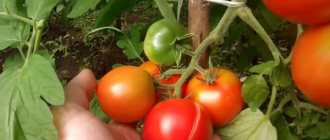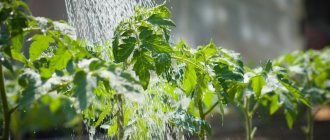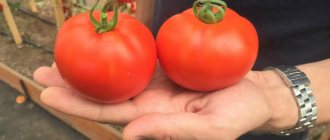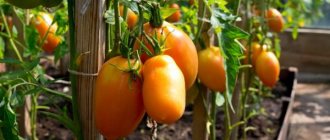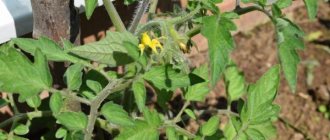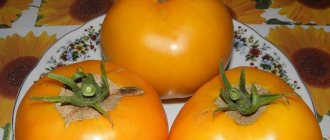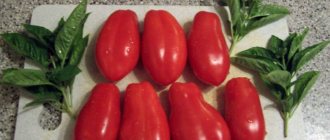Description of the variety
The Adeline variety is distinguished by its unpretentiousness and versatility. The low-growing stem stops growing after the formation of 4, sometimes 5 brushes, which makes caring for the crop easier. The tomato is mid-season. The height of the stem does not exceed 40-50 cm. The leaves of the plant have a bright green color. The oblong red fruits are small in size with a dense skin, fleshy pulp, which is characterized by a sweet and sour taste. Their weight often does not exceed 100 g, which is a huge advantage for supporters of vegetable preservation. The average yield is about 3-4 kg per bush.
Description of tomato variety Adeline
This is a low-growing, mid-season variety of determinate type; the plant reaches a height of no more than 45-50 cm. The bushes are powerful with a strong stem, sparsely leafed or have an average amount of bright green foliage. Due to its small stature, the Adeline bush does not require formation; however, it requires tying to a support, since under the weight of the fruit the stems of the plant break or fall to the ground.
After the fifth leaf, the first flower cluster grows on the stem, the next one is formed after two leaves. In total, no more than five brushes develop on the stem. They bear 7-8 fruits.
From the moment the first shoots appear until the start of harvesting, under favorable conditions, 110-120 days pass. The Adelina variety is included in the State Register of Russia for the North Caucasus, however, the crop can be grown throughout the country. And although the Adeline tomato is intended for cultivation in open ground, when grown in a greenhouse, productivity indicators are not lost, however, the bush becomes longer.
Description of fruits
The fruits have a universal purpose because they are small in size and have thick skin. The average weight of one Adeline tomato reaches 60-95 g; it has an oblong ovoid shape.
The shiny, smooth skin of ripe fruits has a bright red color.
The shiny, smooth skin of ripe fruits has a bright red color.
Inside there are six chambers with a small number of seeds, the flesh is dense, fleshy and juicy, with a sour-sweet taste.
Characteristics of tomato
The Adelina tomato variety is a suitable option for those who do not have enough time to care for the garden.
Main qualities:
- heat resistance of the plant;
- high resistance to diseases and rot;
- good yield;
- versatility of fruit use;
- unpretentiousness in cultivation and care;
- good tolerance to lack of moisture during dry periods;
- intended for cultivation in open ground.
Ripening tomatoes
With timely planting of seedlings and good care conditions, the first harvest of tomatoes can be harvested in the second half of July, enjoying the sweetish taste of the aromatic fruits. An equally important factor is weather conditions - in dry and hot weather, the crop will ripen earlier than in cool and rainy periods. When fully ripened, which proceeds quite smoothly, the tomatoes acquire a scarlet color.
Proper care of ragwort Rowley at home. Raleigh's ragwort - home care, photo
Advantages and disadvantages
Among the main advantages it is worth noting its endurance to high temperatures, which contributes to good ripening of fruits. Due to the presence of a low stem, the bushes do not require staking and pinching, since they belong to determinate varieties, that is, they stop growing at a certain period of development. To obtain a higher yield, you can tie them up, forming a bush of 2 stems. Dense and juicy fruits are great for any type of processing - pickling, pickling, making salads.
Among the disadvantages of the variety is sensitivity to heavy rainfall and excessive watering, as a result of which the plant can be infected with fungal bacteria.
Advantages of the variety
“Adeline” tomatoes have a number of advantages that distinguish the tomato from its analogues, allowing it to occupy a leading position in vegetable gardens. Here are just a few of them:
- high resistance to diseases, in particular to late blight;
- good tolerance to high temperatures, heat resistance;
- It tolerates periods of lack of moisture well and is resistant to drought, which is especially important if there is no possibility of frequent abundant watering during dry summers.
Features of cultivation
After sowing and the appearance of the first shoots, it is necessary to provide the seedlings with the necessary conditions for full development. To do this, it is better to place the box on the windowsill and provide access to good lighting, extending its duration with the help of a lamp. It is necessary to water the seedlings as the soil dries.
After 2-3 leaves appear, the plants must be transplanted into small cups. This procedure should be repeated after 25 days so that the seedlings become stronger and develop the root system well. When planting in the ground, it is recommended to observe the following conditions:
- When planting seedlings, the holes, the distance between which should not exceed 50 cm, should be well moistened and fertilized with humus;
- watering can be done 4-5 days after planting the seedlings;
- regular application of potassium-phosphorus preparations will ensure the full development of the bush and the formation of fruits;
- control the possible growth of stepsons and remove them in a timely manner for the timely ripening of fruits.
Timing of sowing seeds
The average ripening time for Adeline tomatoes is from 110 to 120 days from the appearance of the first shoots. To obtain high-quality and strong seedlings, it is necessary to sow the seeds 65 days before planting in the soil. The average age of seedlings should be at least 40-45 days, that is, it is worth sowing seeds for seedlings in the middle zone no earlier than mid-March. It is necessary to plant strong and hardened seedlings into the soil in the last ten days of May.
Diseases and pests of fruit trees: description and protective measures
Tomato care
In addition to fertilizing with mineral fertilizers, which should be stopped shortly before the tomatoes ripen, it is necessary to loosen the soil. This will provide the root system with not only access to oxygen, but also the necessary nutrients that come in the form of biological products when feeding. When fruits are forming, it is recommended to add diluted ash to the soil. To do this, you need to dilute 50-70 g of ash in 10 liters of water and let it brew for 4-5 days. Watering is recommended in the evening.
Advice ! If the bush has acquired a fairly voluminous shape, it is worth tying the stem to provide access to the fruit to sunlight.
Rules for obtaining a high yield
Healthy bushes give a decent harvest. They are easy to grow. It is required to follow the recommendations of the developers:
- you should start working with seedlings in the first ten days of March;
- after pecking, take the tray to a cool windowsill;
- Be sure to highlight, ventilate, and harden the plants;
- dive after the second leaf grows;
- plant on permanent beds after spring frosts;
- add double superphosphate when planting;
- cover the soil with straw, rotted organic matter, and non-woven material;
- water moderately: after complete drying;
- regularly apply complex fertilizers.
See also
Productivity, characteristics and description of the Blueberry tomato varietyRead
Those who grew tomatoes were convinced of its demands on the structure and fertility of the soil. Soft soil conducts air to the roots, retains moisture, and prevents souring. Loosening - “dry” watering.
Adeline cannot tolerate an excess of nitrogen: she stops setting fruit. You should stop feeding the bushes 14 days before harvesting the first fruits.
Disease resistance
The Adeline tomato belongs to a heat-resistant variety, for which high air temperatures and low humidity levels are preferable. In sunny weather, the plant develops well, which increases its resistance to various microorganisms, including various types of rot. The tomato does not tolerate increased humidity, as a result of which the seedlings are at risk of being affected by the mushroom stalk. And an abundance of prolonged heavy rains can cause a disease such as late blight in an adult plant. Therefore, timely prevention in the form of spraying the plant with special means will only benefit it.
Growing and care
Like all tomato varieties, cultivation begins with planting seeds. Tomato seedlings are planted no later than mid-March. Typically, landing time is in the middle, end of February or early March. Seeds are purchased in the store, it must be in the packaging material. To plant seeds, you can use soil brought from your summer cottage. The soil is pre-treated with a solution of potassium permanganate. The seeds are also briefly soaked in potassium permanganate to prevent contamination.
Important! Treatment of seeds and soil is carried out on the day of planting.
After the soil and seeds have been processed, planting begins. The grains are pressed slightly into the ground and left to germinate. Water the container with the planted seeds with water and cover with cling film. A week after planting, sprouts will appear. Continue to care for hatched tomatoes: moisten the soil as it dries, and keep the film closed.
You may be interested in: Dates for planting tomato seedlings in open ground and greenhouses according to the garden calendar Favorable days for planting tomatoes for seedlings in 2021 according to the lunar sowing calendar Favorable days for picking tomatoes in 2021 after germination: timing of picking tomato seedlings in the table by day
When the seedlings have grown a little and are in the phase of developing the second leaf, pick them. For diving, containers of 300-400 milliliters in size, which are filled with earth, are suitable. You can add one part of humus and peat to the soil. After diving, the seedlings are placed in a sunny place, perhaps on a windowsill, and allowed to strengthen properly. When the height of a tomato bush reaches 15 centimeters or more, it can be transplanted into a greenhouse or outside.
Planting in a greenhouse is carried out no earlier than May, and in open ground - from the middle of the month. The exception is the southern regions, where summer comes much faster. Adeline is considered a frost-resistant variety, so there is no need to worry about the tomatoes after transplanting. They will quickly get stronger and continue to grow rapidly. Immediately after transplanting, the tomatoes are tied to a trellis or support.
Adeline prefers moderate watering, but does not tolerate waterlogging of the soil. Watering with ice water will cause rotting of the root system, and the tomatoes may die. The same goes for overwatering. When watering, you can add chicken manure and saltpeter at the beginning of growing tomatoes. Before flowering, add potassium salt. During fruiting, refrain from watering and using additives.
The holes where tomato bushes grow are regularly kept clear of extraneous grass and weeds, and the soil is loosened to enrich it with oxygen.
Attention! The holes can be mulched with sawdust and straw to protect them from frost and drought. When growing in greenhouses, do not forget to ventilate the greenhouse: open the windows and doors, and close them at night.
Features of storage of the variety
Since the Adeline tomato is a mid-season variety, this indicates that they can be collected for storage. In order to enjoy fresh tomatoes for as long as possible, you should adhere to some storage and harvesting rules:
- It is necessary to pick fruits in the daytime, before the appearance of evening dew, since this reduces their good preservation;
- It is advisable to harvest for storage until the tomatoes have acquired a rich red color (the fruits should be greenish or brown);
- should be stored in a cool, dark place in appropriate containers made of plastic or wood;
- Before storing, you should carefully sort the fruits, selecting only whole and firm tomatoes for storage.
Growing rules
Considering the climatic conditions in Russia, this variety must be grown by seedlings. You need to sow seeds in boxes around the beginning of March. The seedling should be moved to open ground when it has 3 or 4 leaves and its stem and root system are strong.
Planting seedlings
Before planting seeds for seedlings, they must go through certain preparation steps:
- Soak the planting material in a manganese solution, and then rinse them under clean water. The soaking process should last a quarter of an hour. This will disinfect the seeds.
- In order for planting material to actively grow and develop, it must be treated with nutrients. The seeds should be placed in a solution of 1 liter of water and 10 g of nitrophoska. They must lie in this liquid for 1 day.
- Planting material must be kept in moisture at a temperature of 30°C for 1 or 2 days. This procedure promotes rapid germination of seeds.
- The soil for planting seeds must contain useful substances. Also, the soil must have neutral acidity. To sow seeds for seedlings, you can take a mixture of soil, peat, humus and sand.
The process of growing seedlings includes the following steps:
- Prepare plastic containers or wooden boxes. Place the prepared soil in them.
- Make small holes in the ground. Their depth should be approximately 1 cm. They should be placed at a distance of 1 cm from each other.
- Drop the seeds into the holes and cover with soil. Water the soil.
- Cover the container with soil and planting material with glass or film. Place it in a warm and well-lit place.
- After 7-10 days, when the first shoots appear, the container must be moved to a cooler place. It should also be well lit. The film or glass must be removed for 2 hours and returned back.
- When 3-4 leaves are formed on a young plant, it can be moved to open ground.
Tomato transplant
It is necessary to transplant seedlings into open ground or into a greenhouse at the end of spring or at the very beginning of summer. This must be done before the seedlings begin to bloom. Otherwise, there may be a possibility that the tomatoes will partially shed their ovaries.
If the plants will be cultivated in open soil, they must be placed 6 sprouts per 1 sq. m. Adeline tomatoes, as a rule, do not need to be tied up or pinched. After the tomatoes have grown on the first bunch, you should remove the lower foliage on the plant.
Important! When trimming the lower leaves, you do not need to be too zealous, as this can disrupt the processes of photosynthesis.
In a greenhouse, it is imperative to use supports or a trellis. This will greatly facilitate the processes of caring for plants and harvesting. In addition, this will help improve ventilation, which will significantly reduce the occurrence of all possible diseases.
Subsequent care for tomatoes
To care for tomatoes in open soil or in a greenhouse, it is necessary to get rid of weeds, loosen the soil, and also feed it. Watering should be plentiful, but not too frequent, since the plant of this variety does not tolerate too high levels of soil moisture.
The harvest must be harvested as the fruits ripen. It is highly not recommended to leave ripe tomatoes on the bushes for too long, as this will disrupt the process of formation of new clusters.

